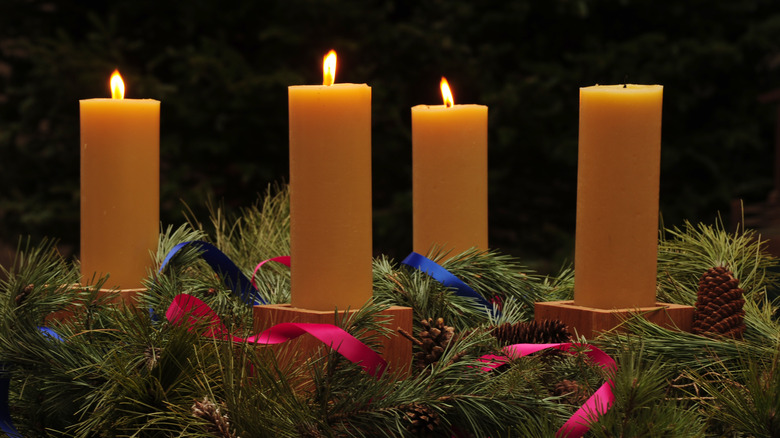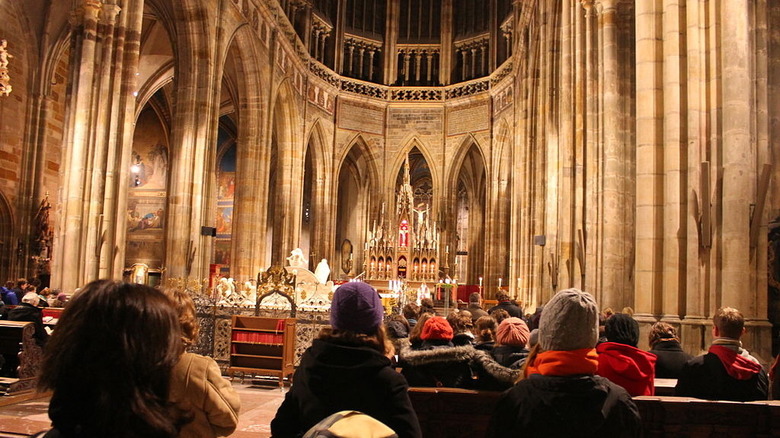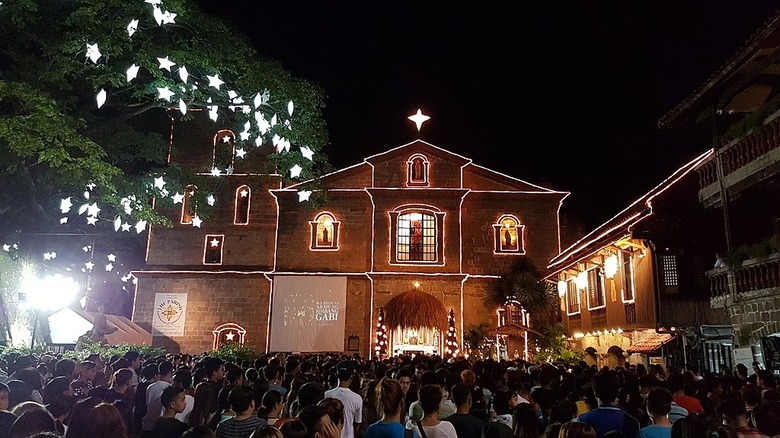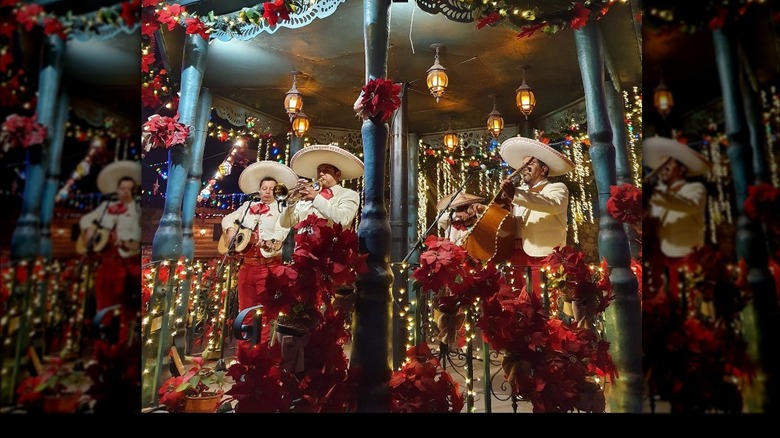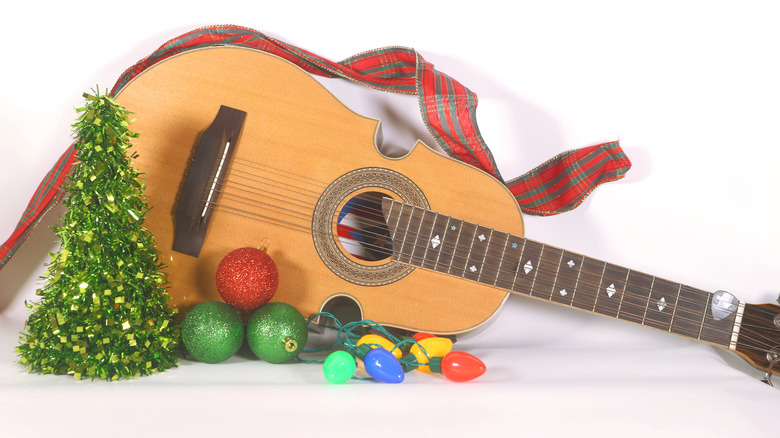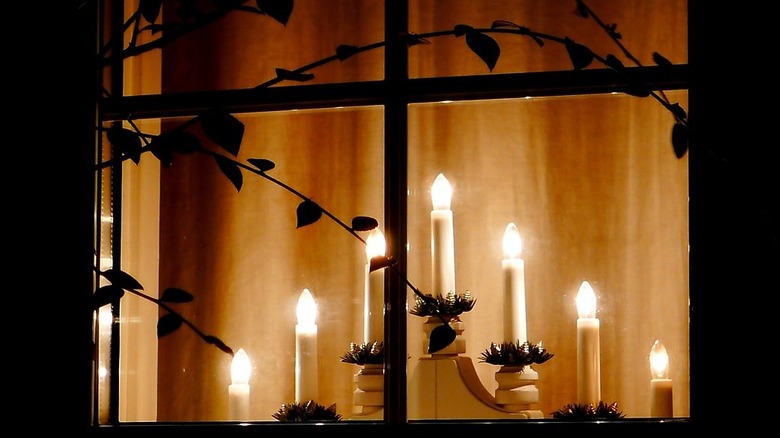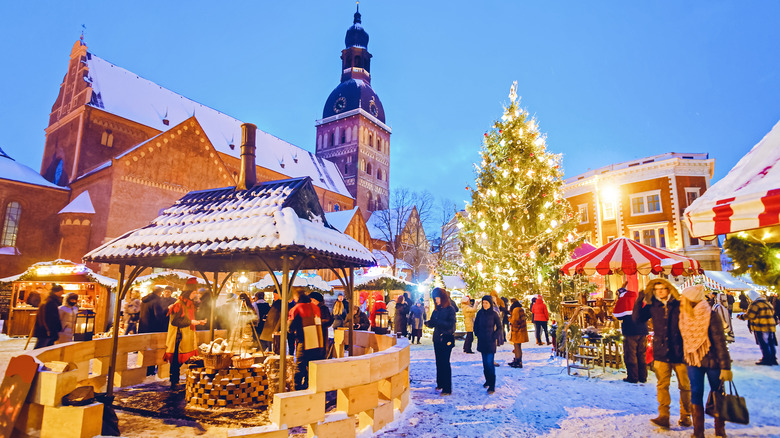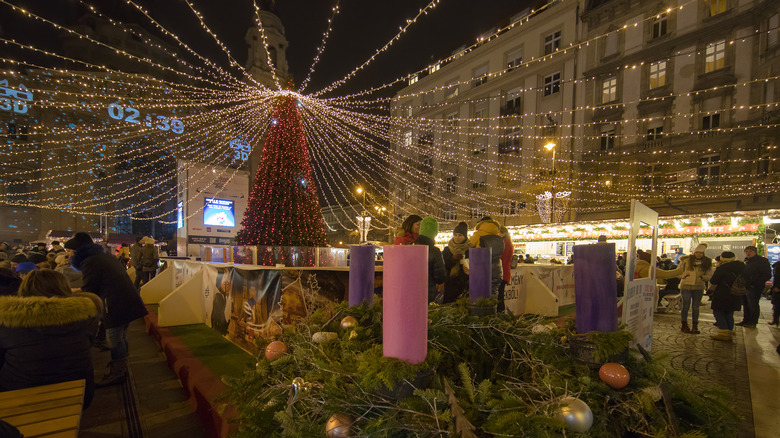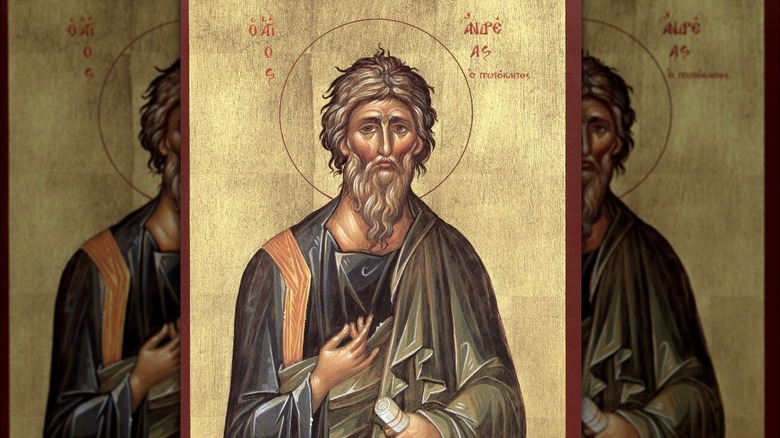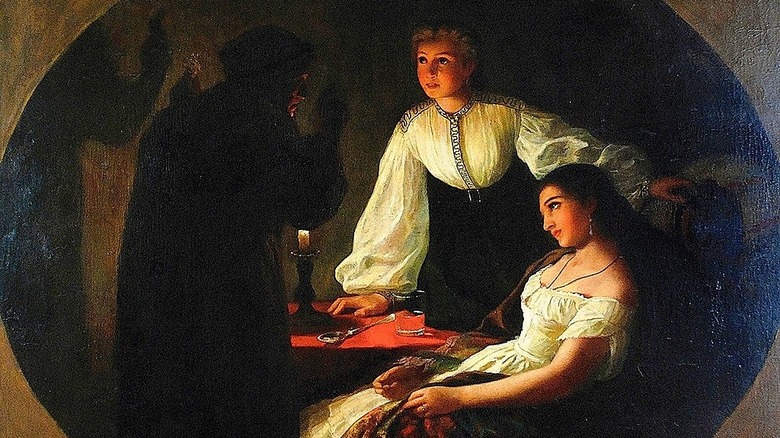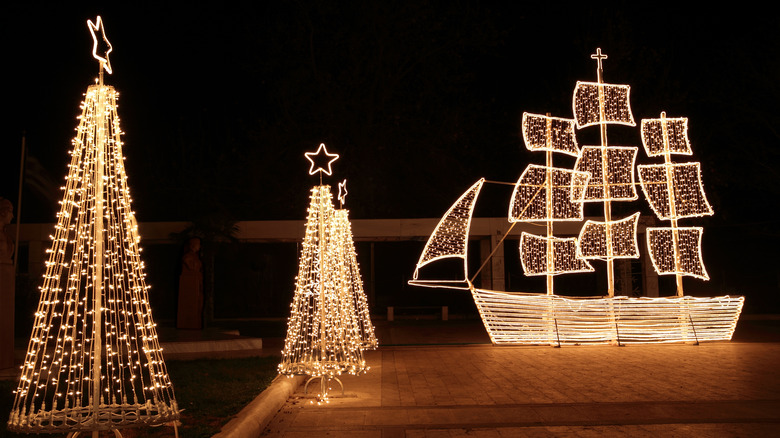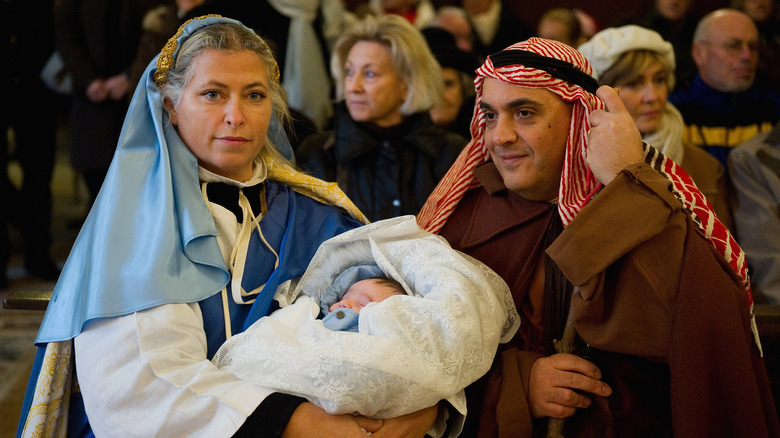Advent Customs From Around The World Explained
Advent is the period in which Christians prepare themselves for Christmas, Jesus' birthday. This period, which varies from 22 to 28 days for Western Christians and 40 for Eastern ones, has traditionally been a time of prayer, fasting, and contemplation. But the world is a big place, and as Christianity has spread throughout the globe, Advent has been modified to suit local tastes and mentalities, resulting in a plethora of customs that run from sacred to mundane and downright hilarious.
Americans are likely to be most familiar with the Advent customs of Protestant Germany, although their meanings are often drowned out in the commercialization of the holiday season. But around the world, there are numerous other customs from the Catholic and Orthodox world that speak to the diversity, beauty, and spirit of the Christmas season. Here are some of the most interesting and well-known customs, along with a few lesser-known ones.
Rorate Masses
In deeply Catholic Poland, Christmas is known as "God's birth." The name suggests the religious significance of Christmas and the Advent preparation period. The centrality of Advent is captured in a beautiful Central and Eastern European tradition called the Rorate Mass. According to Aleteia, the Rorate Mass arrived in 13th century Poland with Boleslaw the Chaste's Hungarian wife, St. Kinga. This Mass, dedicated to the Virgin Mary, takes place early on weekday mornings during Advent well before sunrise. The church is kept dark or dimly lit.
The Mass begins with the chant "come down ye heavens" (in Latin, rorate caeli, which gives the Mass its name). As the Mass goes on, the clergy and members of the congregation have historically lit the seven candles of a menorah placed on the main altar. Members of the congregation are also encouraged to light their personal candles to create a sense of unity. Popular Advent hymns combine with Gregorian chants to create a beautiful and solemn mass setting.
But why begin the Mass in darkness? The entire Mass symbolizes the world gradually approaching the hour of Christ's birth. Since Jesus is called the "light of the world" in the Bible, the candles and lights symbolize Jesus illuminating the darkness and bathing the world in light. By lighting the candles, people declare that they are prepared for the coming of the light (Jesus) to Earth.
Simbang Gabi
The Rorate Mass has a similar counterpart in the Philippines, Asia's Catholic stronghold. During the nine days before Christmas, Filipinos wake up at the crack of dawn to attend a novena of outdoor Masses in honor of the Virgin Mary. These pre-dawn Masses, traditionally known as "rooster masses," allowed farmers and fishermen to hear Mass before they set off to work. According to US Catholic, when these early Masses overflowed during Advent, Filipino clergy requested permission to move Masses outdoors in 1587. Thus, the tradition of Simbang Gabi, literally "night Mass," was born.
According to St. Joseph's Catholic Church of Vacaville, California, Simbang Gabi traditionally began before dawn with bands of musicians rousing the town with Spanish Christmas carols. The music would be followed by church bells summoning people to Mass. At these hours, the roads were dark and people needed some sort of guide to reach the church, where Jesus awaited. Traditionally, Filipinos carried star-shaped lanterns called parols to light the way. Why a star? It symbolizes the white star of Bethlehem that guided the Magi.
According to US Catholic, Filipino immigrants continue to celebrate Simbang Gabi with some practical changes. The Masses are now indoors, and are also offered in the evening across multiple parishes over the nine-day period. The receptions after Masses, which are accompanied by copious amounts of food, provide an opportunity for families to socialize and carry on this centuries-old tradition that captures the religious spirit of Christmas.
Posadas
Catholic Mexico has developed its own religious traditions resulting from a blend of indigenous and Spanish influences. The central Advent tradition in Mexico is called the posada, which literally translates to "shelter" or "inn." Between December 16 and 23, Mexican Catholics (and even some Protestants) combine caroling and processions in a reenactment of the Holy Family's journey from Nazareth to Bethlehem.
According to Catholic Online, posadas begin at the local church with a recitation of the Rosary to the Virgin Mary. The procession, which might range from carrying a nativity scene (sans Jesus) to a live reenactment complete with a donkey, proceeds to a series of houses. The procession sings carols to those inside, requesting shelter (posada). Those inside are supposed to deny them. The procession repeats the process several times until the final house, which has been pre-selected as the place of shelter.
At the final house, the procession is welcomed to a dinner celebration after a time of back and forth caroling. According to the El Paso Times, children smash seven-horned pinatas representing the seven deadly sins and people generally enjoy each other's company as they await the birth of Christ. According to Marquette University, the posada also allows people to truly examine their faith. Are they truly open to welcoming strangers in need? Would people accept the Holy Family today if they showed up on one's doorstep? That is the question, according to Marquette University, that Catholics should ask themselves.
Parrandas
For some, Christmastime is thought of as a time to quietly meditate and reflect on Christ's birth. The Christian Science Monitor notes that this attitude is a product of Northern European, especially German, Christmas traditions. In warmer climates, however, Advent is a time to celebrate Christ's birth with raucous parties and loud music.
The joyous side of Christmas is illustrated in the Puerto Rican Advent party called the parranda (literally "party"). Puerto Ricans gather in the street with their instruments and head to friends' houses in the dead of night. According to El Boricua, these groups "assault" their friends with loud music, traditionally local carols or other Christmas music. Ideally, the "victim" will let them in and an impromptu party begins. The original "victim" then joins the group, which moves between houses eating, dancing, socializing, and drinking. The party traditionally closes with chicken soup at dawn.
Although a parranda is completely foreign to many Americans, these parties are a central part of the Puerto Rican Christmas season. In fact, according to NBC, Puerto Ricans living in the colder areas of the United States report culture shock from the difference in attitude towards the Christmas season. In the end, though, the parranda is just another way of looking at Christmas. After all, the coming of mankind's salvation to earth certainly seems like a good reason to celebrate!
The window candle
According to the Irish Independent, Catholic Ireland's Advent tradition is to place a candle in the window. According to Irish Central, legend tells that the light of the candle indicated the household's openness to sheltering the Holy Family on their trek to Bethlehem. But there was a much more practical purpose to this tradition that relates to resistance against British Protestant rule.
Irish Catholics suffered horribly under British rule. They lost their lands, were starved, exterminated and eventually, many emigrated en masse to the United States. Beginning in 1558, Protestant England tried to force Irish Catholics to conform to the Church of Ireland, an autonomous branch of the Anglican Church. According to the Catholic Encyclopedia, the infamous Penal Laws banned Catholic mass, fined resistors, and stripped away civil rights. Catholic clergy were exiled or executed. In a move that might seem incredible to American Protestants today, Parliament even banned Christmas celebrations in 1647.
Irish Catholics faced a dilemma. They needed to have their Masses, observe Advent, and celebrate Christmas. But this was all illegal. Therefore, Irish Catholics devised a way to mark their houses as Christmas havens. The candle indicated that the house was a safe place for incognito priests to celebrate Mass, which remained illegal until the passage of the Catholic Relief Act of 1791. The tradition has survived into modern times, although its original purpose is obsolete since Ireland is now an independent country
The community Christmas tree
America's most common Christmas symbol is the Christmas tree. Towns and cities put them up, and even non-Christians take part in the tradition. But no one seems to be certain where the tradition of public, decorated Christmas trees originated. According to Atlas Obscura, the Latvian capital of Riga claims the first-ever public Christmas tree. This has led to a rivalry with neighboring Estonia, whose capital Tallinn also claims the title.
Both countries claim that a German mercantile guild, the Brotherhood of the Blackheads, set up a public, decorated Christmas tree in either 1441 (Estonia) or 1510 (Latvia). In Riga's town square, a marker commemorates where this tree allegedly went up. Estonia, however, denies the Latvian claim, since according to Latvian radio station LSM, Latvia never put up a real tree, just a sculpture. So who is right?
According to the Grinches of the world (also known as historians), neither country has any hard evidence to back up their claims. Latvian historian Gustav Strenga (via NPR), concludes that both legends are relatively recent 19th century creations, whereas according to History, the Christmas tree's origins lie in 16th century Germany. This would suggest that the dispute between Latvia and Estonia is over nothing. But Riga and Tallinn were both Baltic German cities, so is it possible that German merchants went public with one of their traditions? It may never be known, but it is certainly an interesting legend and a fun dispute nevertheless.
Advent calendars
Go to any supermarket or department store during the holiday season and you will inevitably find Advent calendars. These tools for counting the 25 days till Christmas often contain toys or chocolate for children. But this tradition is a relatively recent one according to Vox. As far as the historical record attests, Advent calendars were Protestant German replacements for Catholic practices, perhaps to keep children from complaining.
According to Deutsche-Welle, the Advent calendar originated in 16th century German Lutheranism. In Catholic areas, children received presents on St. Nicholas' Day on December 6. According to the St. Nicholas Center, however, Protestant reformers dealt German children a blow and denounced the holiday as Catholic superstition. But Martin Luther, unlike his more radical colleagues, compromised. Instead of receiving gifts on December 6, children would get presents on Christmas Day. But they now had to wait 19 extra days!
The Advent calendar provided a simple fix. For every day of Advent, Protestant children would receive 25 small gifts until Christmas. Catholic adoption of this tradition made it a German custom rather than just a Lutheran one. By the 20th century, it went commercial and today is one of the biggest Christmas traditions among Christians, non-Christians, and even pets.
Advent wreaths
Like Advent calendars and Christmas trees, the Advent wreath is another must-have Yuletide decoration. But like many widespread traditions, the origins are unclear and meaning often misunderstood. According to Catholic Education, it is generally agreed that Advent wreaths originated in Germanic paganism. During the cold, dark winter months, Germanic tribes lit candle-bearing circles of evergreen as signs of hope and beacons of light in anticipation of the arrival of spring. Christianity simply appropriated the Advent wreath and transferred its symbolism to Christmas.
According to Christianity.com, these evergreen circles had multiple layers of meaning, representing the infinity of God and the never ending love of Christ, among other things. The candles generally represented Christ's light in a dark world, although certain colors also carry symbolism. According to Medievalists, 16th-century German Lutherans popularized this old pagan custom among their co-religionists, but there was no "standard" wreath that would be universally recognized today. This would have to wait until the 19th century, when the modern Advent wreath was created as an ad hoc Advent calendar.
According to the Wiehnachts Museum, the modern Advent wreath was the brainchild of Lutheran pastor Johann Wichern, who ran a shelter for orphaned boys. Every day during the Advent of 1838, during prayer times, the pastor lit a candle during prayer times and placed it upon a circular candle holder. Eventually, this was merged with the older tradition of evergreen wreaths to create the modern Advent wreath. The number of candles was reduced to four and spread to German Catholics too, making the wreath yet another German import to the American Christmas scene.
St. Andrew's Novena
On the Gregorian calendar, Advent often begins near St. Andrew's Day, which falls on November 30. According to Learn Religions, with this day comes the St. Andrew Novena. The name suggests that the prayer is addressed to the saint, but it is actually addressed directly to God. It is also not technically a novena, since it is prayed over a 25-day period instead of the usual nine. This one is one of the more challenging spiritual exercises and requires discipline to complete.
The rules of this novena are simple. Catholics petition God with a special prayer 15 times a day, from November 30 to Christmas Eve. Anyone who faithfully prays the requisite number of times will be granted his need. That is, unless God has a better idea, according to the Summit Dominicans. The repeated recitation of the prayer is meant to mentally place the worshipper at baby Jesus' side in Bethlehem. It allows the faithful to mentally place themselves at baby Jesus' side and deliver their petitions to him in what should be a humbling experience. It is not clear where exactly this tradition originated, but the Summit Dominicans note that the St. Andrew Novena is commonly associated with Ireland.
St. Catherine's and St. Andrew's days -- Ukrainian style
Eastern Catholic and Orthodox Christians observe the Nativity Fast instead of Advent. This intense fast requires the faithful to abstain from certain foods on certain days. In Ukraine, however, old pagan superstitions add some levity to this time with two saints days geared towards the young and single. December 7 is St. Catherine's Day. According to the UA Post, Ukrainian girls partake in fortune-telling customs to identify their future husbands. According to the European Students' Forum, one such method is to line up shoes. The girl whose shoes are closest to the door gets married first. Alternatively, throwing a boot behind her and looking at the direction of the heel will point to the direction of her future husband. Some girls will even identify themselves to their suspected future lovers and try to find out their names.
The counterpart to St. Catherine's day is St. Andrew's Day, which Ukrainians celebrate on December 13. This one is literally "for the boys," who at night prank their neighbors, especially families of girls they like. Whether hiding a fence, removing a gate, repainting a house, or putting a plough on a neighbor's roof, Ukrainian village boys enjoy the chance to unwind during a period otherwise dedicated to the intense fasting and spiritual preparation. Meanwhile, girls reprise their fortune-telling activities, making the Ukrainian Advent season an opportunity for matchmaking.
Karavaki
A visitor to Greece during Christmastime may be confused to find decorated boats called karavaki sitting in town squares alongside the much more familiar Christmas trees. In fact, according to Greek Boston, the first Christmas tree in Greece arrived in 1833 alongside the German monarch King Otto I, and the boats are a unique Greek tradition that precede the Christmas tree, harkening back to Greece's millennia-old relationship with the sea and Santa's forerunner, St. Nicholas.
As noted in the National Herald, the karavaki carry multiple associations. The connection with Advent and Christmas is most likely related to St. Nicholas' title as patron saint of sailors and of the Greek nation. St. Nicholas' Day falls on December 6, during the early part of the Orthodox Advent season. In honor of the saint, Greeks decorate karavaki and display them inside the house. According to the Greek Orthodox Archbishopric of Cape Town, this period coincided with Greek sailors' return home to spend Christmas with their families. The boats commemorated their return, and by extension, the saint who kept them safe on their journeys.
The boat is also a symbol of a Christian's journey through life. The Orthodox Church notes that the nave of a church, where congregants sit, is named for its resemblance to a ship. At the helm is Christ himself, leading his congregation through life's many storms and temptations towards eternal life in heaven. These rich Christian associations make the karavaki boat one of the most beautiful and unique Advent traditions that has survived today despite the internationalization of Christmas.
The live-action origin of Nativity scenes
The Nativity scene, like the Christmas tree, is ubiquitous in America's Christian households, regardless of denomination, during Advent. But few are familiar with the origins of this custom, which began in medieval Italy. The Nativity scene dates to 1223, when St. Francis of Assisi created the first one. But it was not made up of statues.
According to US Catholic, St. Francis' visit to the Holy Land in 1221 inspired him to bring Bethlehem to Italy. The Holy Land was too dangerous to visit due to the Crusades, so why not recreate Jesus' birthplace at home? Two years later, as part of the Christmas celebrations in the Italian town of Greccio, St. Francis set up a Nativity in front of a cave where he was saying Mass. But this scene was live. Francis and the local nobility procured actors and animals to stand in front of the altar during the Mass.
The point of the Nativity scene was to allow people to build a Bethlehem at home, even if they could not actually visit the place. The idea quickly caught on as the Franciscan order spread the custom. However, it was impossible to leave live Nativity scenes up for extended periods of time. So craftsmen began creating the scenes composed of statues that are so familiar today. This was probably much better than having to stand in the winter cold as part of a live Nativity scene.
